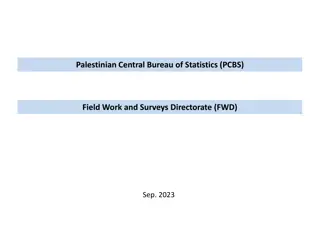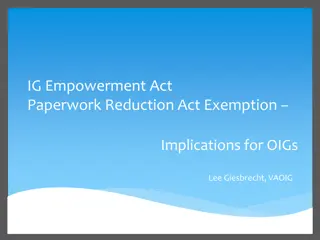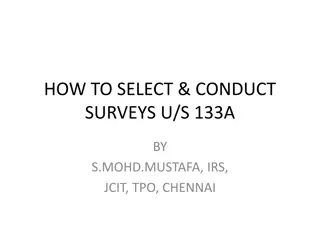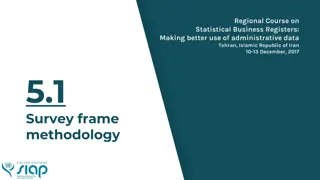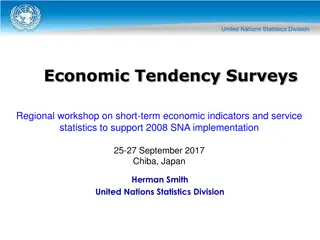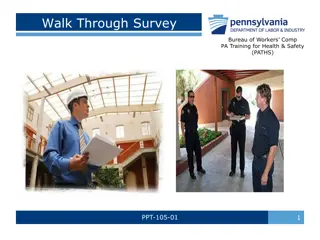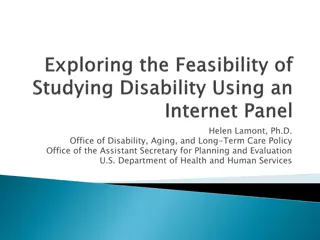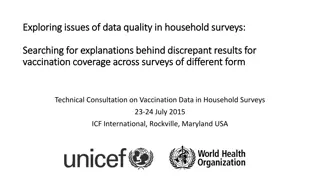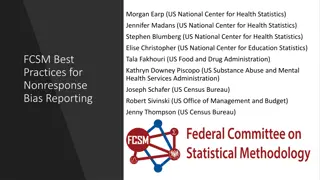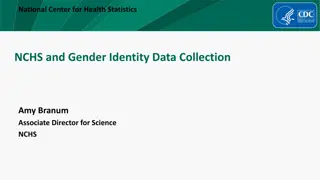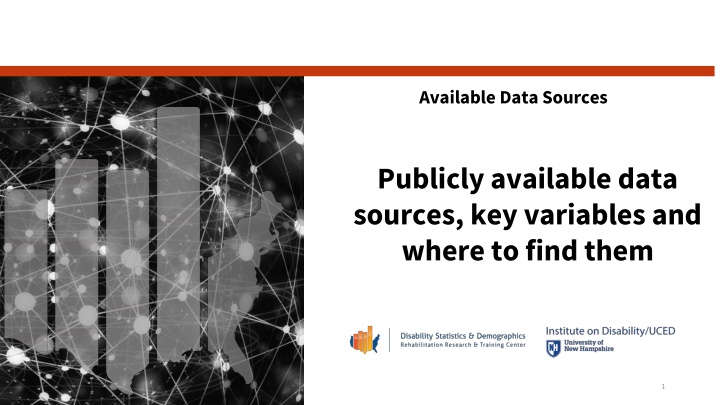
Understanding Federal Surveys and Data Collection
Federal surveys like the American Community Survey (ACS), Current Population Survey (CPS), and more play a crucial role in collecting data to allocate funds, make decisions, and support communities. Learn about key data sources, survey processes, and how collected data drive important decisions and policies. Explore when and how ACS data is utilized, its sample size, collection frequency, and geographic boundaries. Dive into the importance of data-driven decision-making in various sectors such as education, healthcare, and infrastructure. Discover the impact of federal surveys on national and state-level statistics across a wide range of topics.
Download Presentation

Please find below an Image/Link to download the presentation.
The content on the website is provided AS IS for your information and personal use only. It may not be sold, licensed, or shared on other websites without obtaining consent from the author. If you encounter any issues during the download, it is possible that the publisher has removed the file from their server.
You are allowed to download the files provided on this website for personal or commercial use, subject to the condition that they are used lawfully. All files are the property of their respective owners.
The content on the website is provided AS IS for your information and personal use only. It may not be sold, licensed, or shared on other websites without obtaining consent from the author.
E N D
Presentation Transcript
Available Data Sources Publicly available data sources, key variables and where to find them 1
Agenda How federal surveys work? American Community Survey (ACS) Current Population Survey (CPS) Behavioral Risk Factor Surveillance System (BRFSS) Individuals with Disabilities Education Act (IDEA) 2
How Federal Surveys work? Stage 1: Data Collection By mail Paper Respondent In-person interview Surveyagency Internet Online Your community 3
Stage 2: Processing and Dissemination Made available to public Raw data Data combined into statistics Used for research Survey agency Reports, Tables and Applications Shared with.. Federal government agencies, states, tribal and local communities 4
Stage 3: Data-driven decisions Roads Government agencies use these statistics to help with decision making and allocate funds back to the community Schools Hospitals Your community 5
American Community Survey (ACS) Annual nationally representative survey Provides vital information about the people in the US Generates data to determine how federal and state funds are distributed Provides data on jobs, education, veterans, housing situation and many more topics Website - https://www.census.gov/programs-surveys/acs 6
When is ACS data used? To calculate national and state level statistics on the following subjects - Social Housing Disability status Citizenship status School enrollment Economic Employment status Industry and Occupation Earnings Demographic Age Race Sex Sexual orientation Income Education Bedrooms Computer and internet use Vehicles 7
Fact Check Approximately 2 million approximate sample size of the ACS? What is the Annually How often is the ACS data collected? Block groups - See US Census Bureau site for more information census unit? What is the smallest geographic 8
Current Population Survey One of the oldest, largest and well recognized surveys Primary source of monthly labor statistics Provides information about the economic and social well being of people Provides data on employment, child support, volunteerism, health insurance coverage, school enrollment and so on Website - https://www.census.gov/programs-surveys/cps.html 9
When is CPS data used? To calculate monthly national level statistics on the following subjects Social Economic Employment status Industry and Occupation Earnings Demographic Age Race Sex Income Education Supplement Voting and registration Fertility Veterans Civic engagement Disability status Citizenship status School enrollment Marital status 10
Fact Check State level statistics can be calculated easily using CPS. True/False? Monthly How often is the CPS data collected? Approximately 80,000 approximate sample size of the CPS? What is the False 11
Behavioral Risk Factor Surveillance System (BRFSS) Nation s premier system of health-related telephone surveys Collects data about residents health-related risk behaviors, chronic health conditions, use of preventative services and so on Questionnaire divided into 3 parts core component, optional modules, state-added questions Website - https://www.cdc.gov/brfss/index.html 12
When is BRFSS data used? To calculate state level statistics on the following subjects Caregiving Chronic health conditions Disability Arthritis Tobacco use Alcohol consumption Pre-Diabetes Immunization Health care access H.I.V. /AIDS Health literacy Fruits and Vegetables Demographics 13
Fact Check Approximately 400,000 approximate sample size of the BRFSS? Annually How often is the BRFSS data collected? Non- What is the target population of What is the institutionalized adults above the age of 18 years BRFSS? 14
Individuals with Disabilities Education Act (IDEA) IDEA requires the government to provide free appropriate public education to all children with disabilities The U.S. Department of Education collects data on IDEA Using this data, the U.S. Department of Education submits an annual report to the Congress Website - https://sites.ed.gov/idea/data/ 15
When is IDEA data used? To calculate state level statistics on education of children with disabilities. Topics include - Child count Maintenance of effort Educational reduction and coordinated environment early intervening services Discipline Dispute resolution Exiting Personnel 16
Fact Check Which program supports the Office of Special Education Programs IDEA data collection and reporting? To conduct research on education of children with disabilities Children and people with disabilities below the age of 21 years IDEA? What is the target population of How can IDEA data be used? 17
Conclusion ACS provides annual data on jobs, education, veterans, housing situation and many more topics CPS provides monthly data on employment, child support, and so on BRFSS provides data about residents health-related behaviors IDEA provides data on education of children with disabilities 18
References 1. Bureau UC. American Community Survey (ACS) [Internet]. [cited 2019 Oct 29]. Available from: https://www.census.gov/programs- surveys/acs 2. Bureau UC. Current Population Survey (CPS) [Internet]. [cited 2019 Oct 29]. Available from: https://www.census.gov/programs- surveys/cps.html 3. CDC - BRFSS [Internet]. 2019 [cited 2019 Oct 29]. Available from: https://www.cdc.gov/brfss/index.html 4. https://sites.ed.gov/idea/ [Internet]. Individuals with Disabilities Education Act. [cited 2019 Oct 29]. Available from: https://sites.ed.gov/idea/ 19

